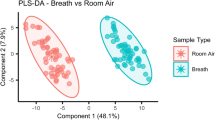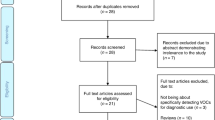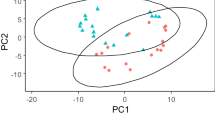Abstract
Objective:
To identify and quantify airborne volatile organic compounds (VOCs) inside neonatal incubators during various modes of operation within the neonatal intensive care unit (NICU) environment.
Study Design:
Air samples were taken from 10 unoccupied incubators in four operational settings along with ambient air samples using air sampling canisters. The samples were analyzed following EPA TO-15 using a Tekmar AutoCan interfaced to Agilent 6890 Gas Chromatograph with a 5973 Mass Spectrometer calibrated for 60 EPA TO-15 method target compounds. Non-target compounds were tentatively identified using mass spectral interpretation and with a mass spectral library created by National Institute for Standards and Technology.
Result:
Two non-target compounds, 2-heptanone and n-butyl acetate, were found at elevated concentrations inside the incubators compared with ambient room air samples. Increase in temperature and addition of humidity produced further increased concentrations of these compounds. Their identities were verified by mass spectra and relative retention times using authentic standards. They were quantified using vinyl acetate and 2-hexanone as surrogate standards.
Conclusion:
The emission pattern of these two compounds and background measurements indicate that they originate inside the incubator. There is evidence that exposure to some VOCs may adversely impact the fetal and developing infants’ health. Currently, as there is no definitive information available on the effects of acute or chronic low-level exposure to these compounds in neonates, future studies evaluating the health effects of neonatal exposure to these VOCs are needed.
This is a preview of subscription content, access via your institution
Access options
Subscribe to this journal
Receive 12 print issues and online access
$259.00 per year
only $21.58 per issue
Buy this article
- Purchase on Springer Link
- Instant access to full article PDF
Prices may be subject to local taxes which are calculated during checkout



Similar content being viewed by others
References
Marklund A, Andersson B, Haglund P . Organophosphorus flame retardants and plasticizers in air from various indoor environments. J Environ Monit 2005; 7 (8): 814–819.
Weisel CP . Assessing exposure to air toxics relative to asthma. Environ Health Perspect 2002; 110 (Suppl 4): 527–537.
Tanaka-Kagawa T, Uchiyama S, Matsushima E, Sasaki A, Kobayashi H, Kobayashi H et al. Survey of volatile organic compounds found in indoor and outdoor air samples from Japan. Kokuritsu Iyakuhin Shokuhin Eisei Kenkyusho Hokoku 2005; (123): 27–31.
Wilford BH, Shoeib M, Harner T, Zhu J, Jones KC . Polybrominated diphenyl ethers in indoor dust in Ottawa, Canada: implications for sources and exposure. Environ Sci Technol 2005; 39 (18): 7027–7035.
Rumchev K, Brown H, Spickett J . Volatile organic compounds: do they present a risk to our health? Rev Environ Health 2007; 22 (1): 39–55.
Leung M, Chan AH . Control and management of hospital indoor air quality. Med Sci Monit 2006; 12 (3): SR17–SR23.
Wolkoff P . Trends in Europe to reduce the indoor air pollution of VOCs. Indoor Air 2003; 13 (Suppl 6): 5–11.
Schecter A, Papke O, Joseph JE, Tung KC . Polybrominated diphenyl ethers (PBDEs) in U. S. computers and domestic carpet vacuuming: possible sources of human exposure. J Toxicol Environ Health A 2005; 68 (7): 501–513.
Wilke O, Jann O, Brodner D . VOC- and SVOC-emissions from adhesives, floor coverings and complete floor structures. Indoor Air 2004; 14 (Suppl 8): 98–107.
Lacasana M, Esplugues A, Ballester F . Exposure to ambient air pollution and prenatal and early childhood health effects. Eur J Epidemiol 2005; 20 (2): 183–199.
Perera FP, Illman SM, Kinney PL, Whyatt RM, Kelvin EA, Shepard P et al. The challenge of preventing environmentally related disease in young children: community-based research in New York City. Environ Health Perspect 2002; 110 (2): 197–204.
Cometto-Muniz JE, Cain WS, Abraham MH, Gola JM . Chemosensory detectability of 1-butanol and 2-heptanone singly and in binary mixtures. Physiol Behav 1999; 67 (2): 269–276.
Cometto-Muniz JE, Cain WS, Abraham MH, Gola JM . Psychometric functions for the olfactory and trigeminal detectability of butyl acetate and toluene. J Appl Toxicol 2002; 22 (1): 25–30.
Boeglin ML, Wessels D, Henshel D . An investigation of the relationship between air emissions of volatile organic compounds and the incidence of cancer in Indiana counties. Environ Res 2006; 100 (2): 242–254.
Sax SN, Bennett DH, Chillrud SN, Ross J, Kinney PL, Spengler JD . A cancer risk assessment of inner-city teenagers living in New York City and Los Angeles. Environ Health Perspect 2006; 114 (10): 1558–1566.
Wogan GN, Hecht SS, Felton JS, Conney AH, Loeb LA . Environmental and chemical carcinogenesis. Semin Cancer Biol 2004; 14 (6): 473–486.
David RM, Tyler TR, Ouellette R, Faber WD, Banton MI . Evaluation of subchronic toxicity of n-butyl acetate vapor. Food Chem Toxicol 2001; 39 (8): 877–886.
Wu T, Bhanegaonkar AJ, Flowers JW . Blood concentrations of selected volatile organic compounds and neurobehavioral performance in a population-based sample. Arch Environ Occup Health 2006; 61 (1): 17–25.
Reinhartz A . Cognitive impairment and olfactory panic from occupational exposure to VOCs. Am J Ind Med 2006; 49 (10): 862–864.
Wolkoff P, Wilkins CK, Clausen PA, Nielsen GD . Organic compounds in office environments—sensory irritation, odor, measurements and the role of reactive chemistry. Indoor Air 2006; 16 (1): 7–19.
Albro PW, Corbett JT, Schroeder JL . Metabolism of methyl n-amyl ketone (2-heptanone) and its binding to DNA of rat liver in vivo and in vitro. Chem Biol Interact 1984; 51 (3): 295–308.
Barber ED, Miller KR, Banton MI, Vijayaraj Reddy M . The lack of binding of methyl-n-amyl ketone (MAK) to rat liver DNA as demonstrated by direct binding measurements, and 32P-postlabeling techniques. Mutat Res 1999; 442 (2): 133–147.
De Ceaurriz J, Micillino JC, Marignac B, Bonnet P, Muller J, Guenier JP . Quantitative evaluation of sensory irritating and neurobehavioural properties of aliphatic ketones in mice. Food Chem Toxicol 1984; 22 (7): 545–549.
Lynch DW, Lewis TR, Moorman WJ, Plotnick HB, Schuler RL, Smallwood AW et al. Inhalation toxicity of methyl n-amyl ketone (2-heptanone) in rats and monkeys. Toxicol Appl Pharmacol 1981; 58 (3): 341–352.
Bowen SE, Balster RL . A comparison of the acute behavioral effects of inhaled amyl, ethyl, and butyl acetate in mice. Fundam Appl Toxicol 1997; 35 (2): 189–196.
Cometto-Muniz JE, Cain WS, Abraham MH, Gola JM . Ocular and nasal trigeminal detection of butyl acetate and toluene presented singly and in mixtures. Toxicol Sci 2001; 63 (2): 233–244.
Iregren A, Lof A, Toomingas A, Wang Z . Irritation effects from experimental exposure to n-butyl acetate. Am J Ind Med 1993; 24 (6): 727–742.
David RM, Tyler TR, Ouellette R, Faber WD, Banton MI, Garman RH et al. Evaluation of subchronic neurotoxicity of n-butyl acetate vapor. Neurotoxicology 1998; 19 (6): 809–822.
Korsak Z, Rydzynski K . Effects of acute combined inhalation exposure to n-butyl alcohol and n-butyl acetate in experimental animals. Int J Occup Med Environ Health 1994; 7 (3): 273–280.
Wensing M, Uhde E, Salthammer T . Plastics additives in the indoor environment—flame retardants and plasticizers. Sci Total Environ 2005; 339 (1–3): 19–40.
Henneuse C, Pacary T . Emissions from Plastics. Rapra Technology: Shrewsbury, UK, 2003.
Cohen J, Gilligan A, Esposito W, Schimmel T, Dale B . Ambient air and its potential effects on conception in vitro. Hum Reprod 1997; 12 (8): 1742–1749.
Gallagher JS, Kurt TL . Neonatal exposure to methyl chloroform in tape remover. Vet Hum Toxicol 1990; 32 (1): 43–45.
Cortes DR, Basu I, Sweet CW, Brice KA, Hoff RM, Hites RA . Temporal trends in gas-phase concentrations of chlorinated pesticides measured at the shores of the Great Lakes. Environ Sci Technol 1998; 32: 1920–1927.
Jedrychowski W, Galas A, Pac A, Flak E, Camman D, Rauh V et al. Prenatal ambient air exposure to polycyclic aromatic hydrocarbons and the occurrence of respiratory symptoms over the first year of life. Eur J Epidemiol 2005; 20 (9): 775–782.
Pinkerton KE, Joad JP . Influence of air pollution on respiratory health during perinatal development. Clin Exp Pharmacol Physiol 2006; 33 (3): 269–272.
Acknowledgements
This study was supported by Advocate Lutheran General Health Partners Endowment.
Author information
Authors and Affiliations
Corresponding author
Additional information
Conflict of interest
The authors state no conflict of interest.
Rights and permissions
About this article
Cite this article
Prazad, P., Cortes, D., Puppala, B. et al. Airborne concentrations of volatile organic compounds in neonatal incubators. J Perinatol 28, 534–540 (2008). https://doi.org/10.1038/jp.2008.75
Received:
Revised:
Accepted:
Published:
Issue Date:
DOI: https://doi.org/10.1038/jp.2008.75
Keywords
This article is cited by
-
Migration of cyclohexanone and 3,3,5-trimethylcyclohexanone from a neonatal enteral feeding system into human milk
Journal of Perinatology (2021)
-
Urinary metabolites of volatile organic compounds of infants in the neonatal intensive care unit
Pediatric Research (2018)
-
Emission of volatile organic compounds from medical equipment inside neonatal incubators
Journal of Perinatology (2014)
-
Volatile organic compounds in the air of neonatal incubators
Journal of Perinatology (2008)



